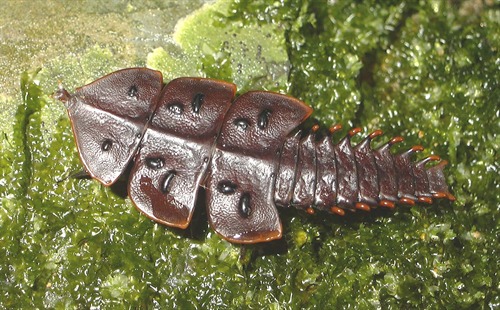
Back
Duliticola hoiseni Wong, 1996
| Family Name: | Lycidae |
| Taxonomic Group: | Invertebrates (Beetle) |
| Common Name: | Trilobite Larva |
Name
Ecology, Habitat & Location
| Ecological Notes | The larviform females apparently feed on the juices in rotting wood that contains a dense fauna of microbes. The diet of makes is not known, but is probably plant juices. They inhabit good forest. The female larvae live on soft rotting wood that is not inhabited by termites. They are most often seen after rain. They probably secrete some unpleasant chemicals as they have not observed to be attacked by birds. |
|---|---|
| Habitats | Forest |
| Distribution | The genus Diliticola occurs throughout Southeast Asia. While there are clearly a large number of different species of trilobite larvae in Southeast Asia, only a few have been described. The main problem in resolving the taxonomy of trilobite larvae is that the males are usually not known. In Singapore, the genus is represented by two species. |
| Nature Reserves | Bukit Timah Nature Reserve |
Conservation
| Trends & Threats | Degradation of forest habitat, and possibly over-collecting by beetle hobbyists. |
|---|---|
| Scientific Interest & Potential Value | The identities of the Malayan "trilobite larvae" were not ascertained until 1993. Duliticola hoiseni occurs in good primary forests in Malaysia, and is known from only two specimens in Bukit Timah Hill. The biological process which describes the condition of the female, ie. in effect "an overgrown, sexually mature baby" is termed neoteny, and is of considerable scientific interest. |
| Conservation Notes | The only viable means of conserving the bizarre genus Duliticola is to ensure that good primary forests continue to be maintained. |
Status
| Singapore Red Data Book Status | Endangered (EN) [2008] |
|---|
Photos
References
| References | Davison, G.W.H., Ng, P.K.L. & Ho, H.C (Eds.). 2008. The Singapore Red Data Book (2nd Edition). Singapore: Nature Society (Singapore). 285pp |
|---|
